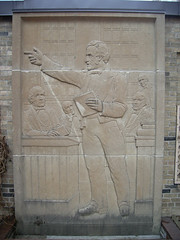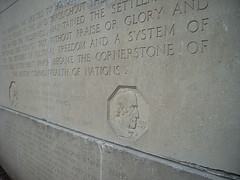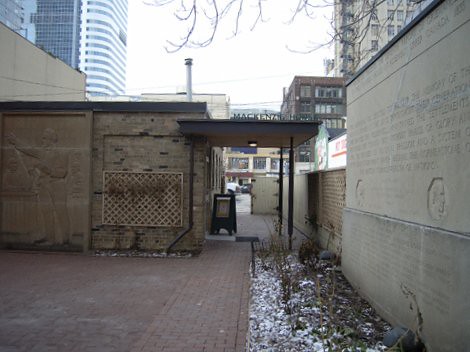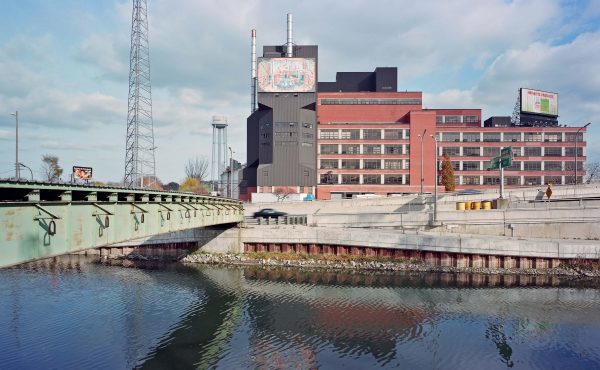

Toronto has its share of odd historic artifacts scattered about town. Some of the most quirky bits, perhaps, are a couple of big stone medallions, back to back, on the northeast corner of Jarvis and Front — just kitty-corner from the South St. Lawrence Market.
Those massive medallions are connected to a large wall of carved stone panels in the side yard of Mackenzie House, a city museum at 82 Bond Street. In both places, the beautiful reliefs seem too grand for their pedestrian setting — and for good reason. The medallions and stone panels are surviving remnants of a large monumental arch, built above Niagara Falls in the dark days of the Great Depression, and created by some of Canada’s best known artists and craftsmen in the inter-war period.
How they were created, and how they got to Toronto, is one of those great little back stories about public commemoration and heritage preservation. Known by a number of names, including the Clifton Gate Pioneer Memorial Arch, what might be called Niagara’s down-sized Arc de Triomphe, was erected as part of a Depression era, make-work redevelopment of provincially-owned land on the edge of the Niagara gorge, including the construction of the Niagara Parkway. The entire project was the under the direction of T.B. McQuesten, Ontario’s Minister of Highways and Public Works in the mid-1930s, who was also responsible for the reconstruction of numerous historic sites around the Great Lakes, such as the QEW.


Top: View of the Memorial Arch and surroundings. The Falls View or Honeymoon Bridge brought American tourists directly to the foot of the Arch. In January 1938, the bridge collapsed, and was replaced with the new Rainbow Bridge, considerably downstream.
Bottom: The Memorial Arch. Note the panel depicting Mackenzie on the inside of the arch, and the medallion on the top right.
Built at the entrance to the new Niagara Parkway, the Memorial Arch was intended to provide a majestic welcome to American visitors who poured over an adjacent bridge to have the Canadian view of the falls. The structure was designed by Toronto architect William Lyon Somerville, who created a distinctly pared down, modern take on its European (and earlier Roman) ancestors. The carved stone reliefs, for their part, were created by the Toronto painter C.W. Jeffreys (the man responsible for many of the artistic recreations of historic events in old Canadian history textbooks) and Toronto sculptors Emmanuel Hahn and Louis Temporale.
On the west side of the arch was a depiction of the discovery of Niagara Falls in 1679. Next, on the western inner wall of the arch, was a depiction of the arrival of United Empire Loyalists during the American Revolution. Across the arch,  William Lyon Mackenzie and the Rebellions of 1837-38 took prominence. The east side of the arch, facing the American border, commemorated the War of 1812. Inscriptions dedicated the arch to “the pioneers of political freedom and a system of responsible government which became the cornerstone of the British Commonwealth of Nations.†Biblical texts were chosen by then Prime Minister Mackenzie King, whose grandfather William Lyon Mackenzie was featured so prominently on the monument (Though King cautioned McQuesten against highlighting the rebellions as the key event on the road to democracy in Ontario, he was more than pleased at the recognition of his grandfather’s place in Canadian history).
William Lyon Mackenzie and the Rebellions of 1837-38 took prominence. The east side of the arch, facing the American border, commemorated the War of 1812. Inscriptions dedicated the arch to “the pioneers of political freedom and a system of responsible government which became the cornerstone of the British Commonwealth of Nations.†Biblical texts were chosen by then Prime Minister Mackenzie King, whose grandfather William Lyon Mackenzie was featured so prominently on the monument (Though King cautioned McQuesten against highlighting the rebellions as the key event on the road to democracy in Ontario, he was more than pleased at the recognition of his grandfather’s place in Canadian history).
Beneath the depiction of Mackenzie were two reliefs, in profile, of Peter Mathews and Samuel Lount, executed in Toronto for  their role in the rebellion, and a list of the names of others convicted of treason and hung for their role in the rebellion as well. Not surprisingly, the arch was unveiled on the 100th anniversary of the rebellions in 1938, with Mackenzie King playing a very proud role in the presentation ceremonies.
their role in the rebellion, and a list of the names of others convicted of treason and hung for their role in the rebellion as well. Not surprisingly, the arch was unveiled on the 100th anniversary of the rebellions in 1938, with Mackenzie King playing a very proud role in the presentation ceremonies.
A mere 29 years later, the arch was demolished. When the bridge adjacent to the arch was replaced by the current Rainbow Bridge farther down the river, the arch lost its prominence as a gateway. Then, with great irony, the beautiful memorial arch was declared a traffic hazard and replaced with a parking lot — all at the end of Canada’s centennial year, 1967, the most expensive commemoration of “the nation†ever staged. Pieces of the monument were hauled off to a Parks yard, and the site was cleared for an expansion of the roadway.
In 1974, a curious Toronto reporter, Mark Frank, discovered the remains of the arch, abandoned outside in the Parks facility. The Toronto Historical Board (now Heritage Toronto) led a charge to have some remaining pieces of the arch restored and re-placed in Toronto. Two large medallions, one depicting the Griffin, the ship of the French explorer La Salle (and which stood above the portrayal of his “discovery†of Niagara Falls) and the other of the St. Lawrence, a War of 1812 British gunship (which stood above the depiction of that war on the arch) were retrieved. So were pieces of the dedication, the portrayal of Mackenzie, the reliefs of Lount and Mathews, and the list of those executed for their role in the 1837-38 rebellions. Various proposals to place the pieces in public parks were put forward — a fountain at Berczy Park (then being redesigned) was considered, as was an expanded parkette north of Mackenzie House. In the end, the medallions, placed back to back, were installed at Front and Jarvis, with two plaques to describe their significance. Close to the former lake shore, the current site of the medallions was considered appropriate for their depiction of two of Canada’s most historic ships. When the parkette next to Mackenzie House did not materialize, the Mackenzie panels were reconstructed in the side yard of Mackenzie House itself.
Though now in contexts much reduced in glory, the bits of beautifully carved stone are worth a closer look.

Sideyard of Mackenzie House, 82 Bond Street, showing installation of panels from the Memorial Arch. Note the Mackenzie panel at rear left.
Top and bottom photos by Gary Miedema, other photos courtesy of Niagara Falls (Ontario) Public Library
– – – – – – – – – – – – –
Gary Miedema is a historian with Heritage Toronto and a regular contributor to Spacing. He is also the author of For Canada’s Sake: Public Religion, Centennial Celebrations, and the Re-making of Canada in the 1960s (McGill-Queen’s University Press, 2005). He is also a Research Associate at Victoria College, University of Toronto, and teaches in Ryerson University’s School of Continuing Education.




6 comments
Being from Niagara (Welland) I’ve seen those pictures a couple times, but never knew what happened to the arch. Thanks for telling its tale.
Last year for school, while working on a research paper about the Welland Canal and the Railways that cross the mid-peninsula I stumbled across an old academic paper from the 80’s that outlined the hopes and dreams of some in Niagara in creating a super city in the late 1800s. They expected the city to rival other great cities in size and stature and expected Niagara Falls to be the catalyst for this growth (due to its ability to produce power). Obviously that never happened and now outside of the couple square kms that inhabit mostly tourists, the city is pretty dead (much like most of Niagara really). For those interested, here’s the link to the article: http://links.jstor.org/sici?sici=0004-5608(198703)77%3A1%3C48%3AITFANF%3E2.0.CO%3B2-V
Absolutely love the quaint little customs stations at the foot of the bridge in the photo. Compare those to the monstrous toll-plaza-like things that we have today on the borders (which still can’t get the job done without causing massive backups)… A simpler time.
I’ve always loved the little modern addition/overhang on MacKenzie House & the nice font of those standing letters.
—
And should also note that the high school where young Jordan Manners was shot to death last year in North York is named after C.W. Jeffreys.
That reminds me… I’ve been meaning to visit Guildwood Park in Scarborough. I chanced upon a website ( http://www.ruthard.ca/art/scarborough.htm ) with photos of the sculpture garden that contains salvaged architectural pieces of “extinct” Toronto buildings!
The Lount and Mathews reliefs should be located in the handsome little ‘parkette’ off Court St. It was here that they were hung. Gallows were erected behind the old gaol that stood on the northeast corner of King and Toronto Sts.
The back(south) facade of Fredrick Cumberland’s York County Court House (57 Adelaide St. E.) forms the backdrop to what is one of Toronto’s finest hidden public spaces.
A great idea. In fact, the entire commemorative inscription, with the reliefs of Lount and Mathews and the names of all others who were executed for their role in the rebellion, would have been a fabulous edition to Court House Square. My guess is that the Landscape Architects weren’t aware of their existence.
As an aside, there were two huge chunks of stone, with biblical inscriptions, which were also considered for parks in Toronto. I don’t know where they ended up…